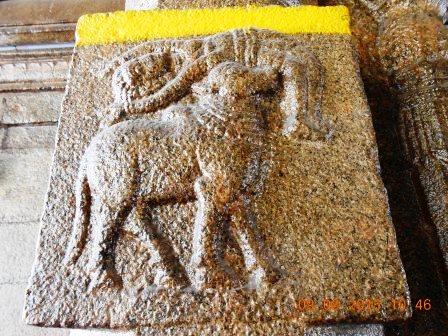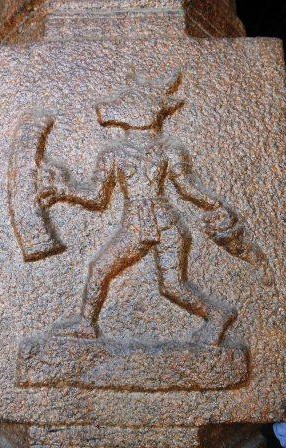- The Vilwanatheswarar Temple, also spelled Bilvanathesvara Temple, is a prominent Hindu temple dedicated to the deity Shiva, located in Thiruvalam, a village in Vellore district of Tamil Nadu, South India. The temple's main deity is worshipped as Vilwanatheswarar, represented by a Shiva lingam, while his consort Parvati is depicted as Vallambigai. This temple holds special significance as it is revered in the 7th-century Tamil Saiva canonical work, the Tevaram, composed by the Tamil saint poets, the Nayanmars, and is classified as a Paadal Petra Sthalam.
- The temple complex spans about one acre and is entered through a prominent five-tiered gopuram (gateway). Within the temple, there are several shrines, with those dedicated to Vilwanatheswarar and his consort Vallambigai being the most prominent. These shrines are enclosed by large concentric rectangular granite walls, contributing to the temple’s grandeur.
- The temple also houses historical inscriptions dating back to the 8th century, particularly from the Nandivarman II era. One of the earliest inscriptions, located on the north wall of the temple, mentions the Tevaram singers, highlighting the temple's association with the early Tamil saints.
- Historically, during the reign of King Rajaraja Chola, the region, including the area from present-day Chittoor to Hosur, was part of the Thondai Mandalam. The region was ruled by the legendary Vandhiya Thevan (also known as Vallavarayan Vandhiyaththevan), who considered the temple’s deity Vallanathar (another name for Shiva) as his family deity. Interestingly, the town Thiruvalam was originally known as Thiruvallam, with Vandhiya Thevan being closely associated with the area.
- Just outside the temple, there is the Samadhi (final resting place) of the revered saint, Thiruvalam Swamigal. Based on historical records, it is inferred that the temple of Vilwanatheswarar predates the construction of the Tanjore Brihadeeswarar Temple, making it an important historical and religious site in Tamil Nadu.
PURANIC SIGNIFICANCE:
The Origin of the River Name: Neva River
The Neva river, also known as the Ponnai river, is closely linked to another story. Lord Shiva is believed to have called out "nee vaa," meaning "come here," which is said to be the origin of the river's name.
The Vilva Forest and the Lingam
Thiruvallam is also associated with the concept of a Vilva forest (Vilavanam), which was once inhabited by a termite hill. A cow that used to milk water from this hill contributed to its transformation. Over time, the termite hill drained and became a Lingam, which later became the focal point of the temple that exists today.
Inscriptions and Historical References
The temple is historically referred to as "Theekali Vallam" in the inscriptions found within the temple. The Tamil poet Sambandar, in his verses, referred to the location as Thiruvallam, while the 15th-century poet Arunagirinathar called the temple "Thiruvalam" and referred to the presiding deity as "Thiruvallam Udaiyar."
This rich history and the legends surrounding Thiruvallam make it a significant and revered site in Hindu mythology and temple tradition.
The Legend of the Vilwa Forest and the Swayambu Lingam
In ancient times, the region surrounding Thiruvallam was densely covered with Vilwa trees. According to legend, some locals noticed a cow that poured its milk on a particular ant-hill every day. Upon investigating, they discovered a Swayambu (self-manifested) Lingam beneath the ant-hill. They cleared the area and built a temple around the Lingam. It is believed that this region was originally a Vilwa forest, hence the association with the Vilwa tree in local folklore.
The Demon Kanjan and Nandi's Intervention


The temple's legend also includes a story involving a demon named Kanjan. The temple priest, who used to fetch water for Pooja and Abishekam, was troubled daily by the demon. Upon hearing the priest's complaints, Lord Shiva instructed his mount, Nandi, to deal with the demon. Nandi carried out Shiva's command and killed Kanjan, tearing him into eight pieces. These eight parts fell in different locations, which are now associated with Shiva temples:
- Lalapettai (skull)
- Seekarajapuram (head)
- Maveri (chest)
- Vadakal (right leg)
- Thenkal (left leg)
- Maniampattu (wrist)
- Kugayanallur (intestines)
- Narasingapuram (nerves)
- Maruthampakkam (thorax)
After his death, Kanjan sought forgiveness from Lord Shiva. The lord granted his plea and blessed him with "Mukthi" (liberation). Shiva further declared that wherever Kanjan’s blood had fallen, a Shiva Lingam would appear. Even today, many Shiva Lingams can be found on the nearby hill, and it is believed that digging on the hill will reveal more Lingams. In commemoration of Nandi’s role in protecting the temple, the Nandi idol at this temple faces away from Lord Shiva and gazes toward the nearby hill, Kanjangiri, where Kanjan's parts fell.
The legend of Nandhi fighting with the demon Kanjan is depicted in a sculpture in the hall (Sabha Mandapam) and also in the form of reliefs chiseled on the hall pillars.
The Mango Contest: Lord Ganesha and Lord Subramanya
A well-known legend at Thiruvallam involves a contest between Lord Ganesha (Vinayaka) and Lord Subramanya (Muruga) over a mango offered by Sage Narada. The challenge was that whoever circled the world first and returned would receive the fruit. While Subramanya quickly embarked on a journey around the world, Ganesha, who had a smaller mount, a rat, chose to circumambulate his divine parents, Lord Shiva and Goddess Parvati, three times. He explained that, for him, his parents were his world. Impressed by this wisdom, Lord Shiva awarded the mango to Ganesha.
This event is significant as it established the idea that the "world" means one's parents. The place where Ganesha performed this sacred circumambulation is believed to be Thiruvallam. The Tamil word "Valam" means circumambulation, and this is where Ganesha proved that the "world" is embodied in the sacred relationship with one's parents. Over time, the name of the place evolved from Thiruvalam to Thiruvallam.
The Name of the Temple and Lord Vinayaka
In recognition of the contest and Ganesha’s wisdom, the Vinayaka here is known as "Kani Vangiya Vinayagar," which means "the Lord who received the fruit." This title highlights Lord Ganesha’s role in obtaining the fruit and the temple’s association with this legendary event.
Swayambu Lingam:
According to legend, in ancient times this region was densely covered with Vilva trees. It is believed that once, a few locals had noticed a cow pouring its milk on a particular ant-hill every day. After clearing that place, they found a Swayambu lingam and built a temple around it.
Story behind the name of Neeva River:
It is believed that since Lord Shiva found that the temple priest was struggling to bring water from the nearby river, he called the river to come near his temple. The river changed its course and started flowing near the temple. Since Lord Shiva called the river to come near to his temple (“nee vaa” meaning come here in Tamil), this river is now called Neeva.
Mukthi Sthalam:
Another legend related to this temple is that once a person was on his way to Kasi to dissolve a relative’s ashes (“Asthi”) in the Ganges. Since Thiruvalam was a famous pilgrimage centre in the past, he decided to take some rest here and he kept the ashes near the temple tank. When he decided to resume his journey, he was surprised to see the Asthi changed to jasmine flowers. He proceeded to Kasi as planned and after reaching there, another surprise awaited him – the jasmine flowers had again changed back to ashes.
Since he found that the Thiruvalam temple had changed the ashes into jasmine flowers, he decided not to dissolve the ashes in the Ganges, but instead bring it back to this temple and dissolve it in the temple tank itself. This temple is considered as holy as Lord Visvanatha temple in Kasi. This temple is also referred to as a Mukthi Sthalam (a place to attain salvation).
Theekkali Vallam:
It is said that Lord Shiva was worshiped by a demon (asura) called Theekkali, so this place is also known as Theekkali Vallam.
Adhi Sankara pacified Mother here:
Earlier the temple was called Theekkali Vallam. The Ambal's name of this temple was known as Theekkali Ambal (Jadaakalaabambal) and she was adorned with an angry look. The Sthala Puranam says that Sri Adhi Sankara calms Ambal.
Thiruvalam:
It is believed that Lord Ganesha and Lord Subramanya had a quarrel for a mango fruit offered by Sage Narada. A contest was conducted that whoever goes around the world first and comes back here would be offered the fruit. While Lord Subramanya went around the world, Lord Ganesha encircled his Parents and got the fruit as a token of appreciation. Valam in Tamil means circumambulation. This is the place where Lord Vinayaka established the truth that “world” means Father and Mother and “Father and Mother” mean world.
He went around his Divine parents to show this truth. As he did the Valam here, the place came to known as Tiruvallam and changed as Tiruvallam. The famous competition between Vinayaka and Subramanya took place at Thiruvalam contrary to another version that states that the competition took place at Kailasam. ‘Thiru’ means ‘Sacred’ or ‘Holy’ while ‘Valam’ means ‘Circumambulation’. Here the Vinayakar is called “Kani Vangiya Vinayagar” (the lord who received the fruit).
Lord Mahavishnu worshiped Lord Shiva here:
As Lord Mahavishnu worshiped Lord Shiva here, his footprint is kept for worship in front of the flag post.
Vilvaranyam:
This is a legendary temple with great importance attached to it. This area of the temple was a forest full of Vilva Trees. Hence it was called as Vilvaranyam or Vilvavanam.
ADMINISTRATION:
The administration of the temple is typically managed by the Hindu Religious and Charitable Endowments (HR&CE) Department under the Government of Tamil Nadu, or it may also be managed by a local temple trust or mutt depending on the specific temple.
.jpg)
